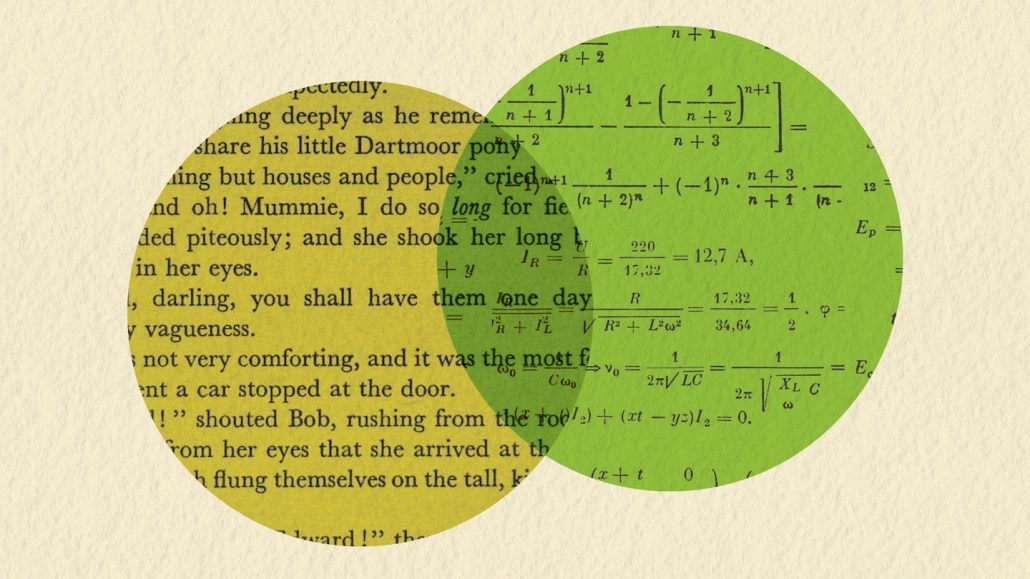
Math plays a role in all sorts of literature.
C. Chang

Once Upon a Prime
Sarah Hart
Flatiron Books, $29.99
“Mathematical symbolism and metaphor are present in every kind of literature, from the humblest of fairy tales right through to War and Peace,” claims mathematician Sarah Hart. In Once Upon a Prime, she lays bare some of this hidden math and meaning in a host of poetry, novels and folklore.
She starts with nursery rhymes, often rife with counting — such as “One, Two, Buckle My Shoe” — showing how numbers bleed into our very first encounters with the world of words. This is not just through counting but also more subtly through the rhythms and rhyme patterns. It’s also through trebling — where a word or phrase is repeated three times, such as “Row, row, row your boat.”
The number three has a special hold on Western literature and languages in general. It pervades common phrases — “Three cheers for…,” “Ready, Set, Go,” “Learning your ABCs.” It’s also central to story structure; for example, trilogies are more prevalent than tetralogies. Characters tend to come in threes too, like “The Three Little Pigs,” and even in jokes like “A priest, a minister and a rabbi…”
Hart suggests this emphasis on three has some basis in geometry. Three is the minimum number of points that can define a two-dimensional shape, and the minimum number of sticks that can be bound to make a stable rigid structure, that is, a triangle. And the equilateral triangle is the only shape with both equal-length sides and equidistant corners. These geometric properties give the number three “a sense of strength and completeness, and also often of equitability,” Hart writes.
It’s a poetic argument, if not completely convincing. To bolster her case, she also points to trichotomies. Take a number, any number, and every other number is either more, less or equal to that number — a trichotomy that has direct parallels with Aristotle’s doctrine of the mean: “Every ethical virtue is a golden mean (just right) between two vices — one an excess, the other a deficiency,” as Hart describes it. This doctrine is playfully illustrated in Goldilocks’ experiences with porridge, chairs and beds.
For a book about math and literature, it’s not surprising that Hart focuses quite a bit on poetry, which is often defined by patterns of some sort. Perhaps more revelatory is her look at how math also molds the structure or pace of novels.
For example, I had noticed Amor Towles was not moving through time in a strictly linear fashion when I read his 2016 book A Gentleman in Moscow, but I completely missed how the number two orchestrates the story’s structure. The novel takes us through 32 years in the protagonist’s life, starting in 1922 when he begins living under house arrest. Each chapter advances in a roughly doubling interval of time since his sentence begins: the first day after, then the second, fifth, 10th, three weeks after, six weeks after and so on. Then from the middle of the book, the intervals climb down again, reversing the sequence.
Some readers may wonder if Hart’s love of math simply leads her to find patterns like this everywhere. But the odds must be astronomically high for the examples she presents to be mere chance.
Among the numerous math-loving authors Hart cites is Herman Melville, who steals the limelight for a good 10 pages that are sheer joy to read. Melville tended to lace his novels with so much philosophy and mathematics that his publisher worried about profitability. At one point, Melville promised his next novels would have “no metaphysics, no conic-sections, nothing but cakes & ale.” He did not keep that promise. One of his next books was Moby-Dick. The novel is thick with math, from the concept of a quoin — a kind of lopsided wedge, which the main character Ishmael defines through geometric descriptions of a sperm whale’s head — to the analogy for how such a creature must see two distinct views of the world from eyes on either side of its head, “as if a man were able simultaneously to go through the demonstrations of two distinct problems in Euclid.”
Cover to cover, Hart’s love of math fizzes off the page, such as when she implores readers to put down the book and twist a line of paper into a Möbius strip. She admits it’s a bit of a detour, but in her defense, it is leading up to a discussion of a 1974 short story called “Mobius the Stripper,” which has a particular kind of circular narrative.
Hart’s simple breakdowns of both math and literature make the book easy for anyone to follow, no matter their proficiency in either subject, though a familiarity with some of the math and literature references might make for a slightly more satisfying read. Not everyone will finish the book primed (ha!) to discover the mathematical gems hidden in a book or poem. But that takes little away from the charm of reading Once Upon a Prime, a joyous tour de force of mathematical and literary delights.
Buy Once Upon a Prime from Bookshop.org. Science News is a Bookshop.org affiliate and will earn a commission on purchases made from links in this article.






